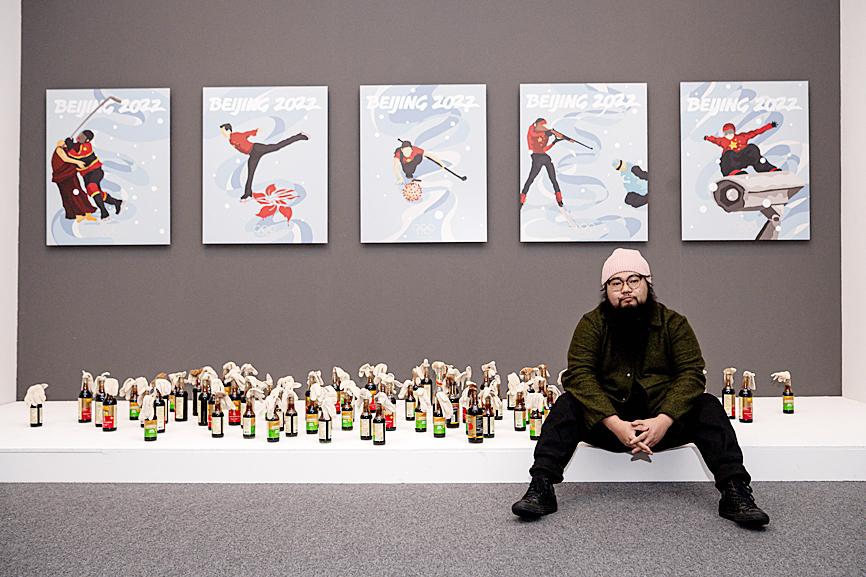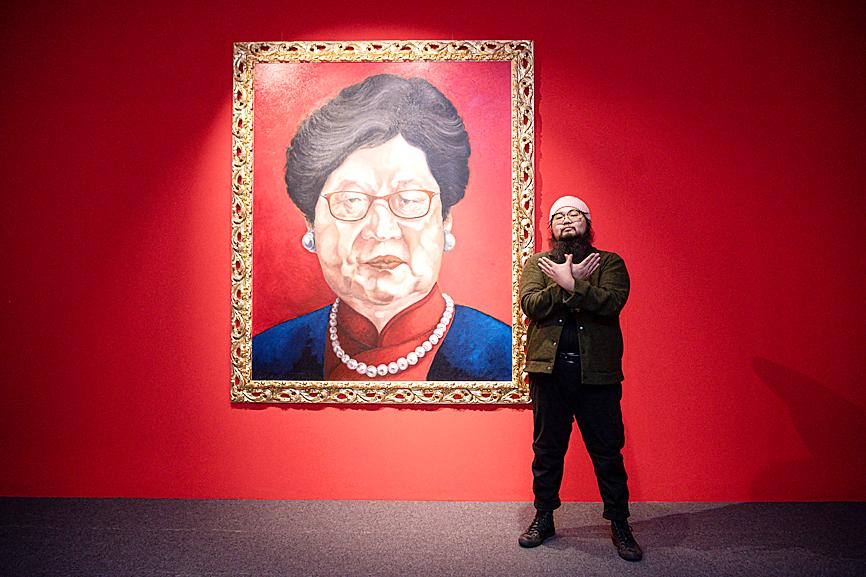Exhibiting a torture instrument as an innocent rocking chair, Chinese dissident artist Badiucao (巴丟草) mocks the propaganda of Beijing in a new show — while appropriating its codes.
Defying calls from the Chinese government to cancel it, the northern Italian city of Brescia is hosting the first international solo exhibition by the 35-year-old artist and exile from China who lives in Australia.
Badiucao’s works are “full of anti-Chinese lies” that “jeopardize the friendly relations between China and Italy,” the Chinese embassy in Rome said in a letter sent last month to Brescia’s town hall.

Photo: AFP
However, the city stood its ground.
“None of us in Brescia, neither in the city council nor among the citizens, had the slightest doubt about this exhibition going ahead,” Brescia Deputy Mayor Laura Castelletti said.
Brescia, known for its Roman ruins, has a long tradition of welcoming dissidents, painters and writers, in the “defense of artistic freedom,” she said.

Photo: AFP
The last was in 2019, with the works of Kurdish artist Zehra Dogan, who spent nearly three years in jail in Turkey. The new show, “China is (not) near — works of a dissident artist,” which opened on Friday, denounces political repression in China and the country’s censorship of the origins of COVID-19, two explosive subjects for Beijing.
The exhibition, whose title alludes to a famous Italian film from 1967, China Is Near, runs until Feb. 13 next year at the Santa Giulia Museum.
In an interview, Badiucao — who has been called “the Chinese Banksy” — said he was “very happy and proud” that the city “had the courage to say ‘no’ to China to defend fundamental rights.”
“I want to use my art to expose the lies, to expose the problems of the Chinese government, to criticize the Chinese government. However, on the other hand it’s also celebrating the Chinese people, for how brave Chinese people are ... even when they have been subjected to this very harsh environment with an authoritarian government,” Badiucao said, speaking in English.
Plans for a Hong Kong show in 2018 fell through after pressure on the artist and his entourage, said the bespectacled Badiucao, who sports a long, shaggy beard.
“The national security police went to intimidate my family in Shanghai,” he said, adding that they threatened to “send officers” to the opening if the exhibition was held.
Among the works exhibited in Brescia that have provoked the ire of Beijing is a famous image of Chinese President Xi Jinping (習近平) merged with the face of Hong Kong Chief Executive Carrie Lam (林鄭月娥) to illustrate the erosion of self-rule in the former British colony.
The Chinese Communist Party “thinks that all free artists are its enemies, that’s why it hates me so much,” said Badiucao, adding that he receives “daily death threats” on social media.
Due to heavy censorship, he said he only learned decades later as a university student studying law in China about the government’s brutal 1989 crackdown on protesters in Tiananmen Square.
Badiucao decided to dedicate himself to art, moving to Australia in 2009 and only revealing his identity publicly on its 30th anniversary a decade later.
Another of his works depicts 64 watches painted with the artist’s own blood, representing those given to Chinese soldiers as a reward for their participation in the bloody Tiananmen Square Massacre, Badiucao said.

The Chinese People’s Liberation Army (PLA) is constructing a new counter-stealth radar system on a disputed reef in the South China Sea that would significantly expand its surveillance capabilities in the region, satellite imagery suggests. Analysis by London-based think tank Chatham House suggests China is upgrading its outpost on Triton Island (Jhongjian Island, 中建島) on the southwest corner of the Paracel Islands (Xisha Islands, 西沙群島), building what might be a launching point for an anti-ship missile battery and sophisticated radar system. “By constraining the US ability to operate stealth aircraft, and threaten stealth aircraft, these capabilities in the South China Sea send

HAVANA: Repeated blackouts have left residents of the Cuban capital concerned about food, water supply and the nation’s future, but so far, there have been few protests Maria Elena Cardenas, 76, lives in a municipal shelter on Amargura Street in Havana’s colonial old town. The building has an elegant past, but for the last few days Maria has been cooking with sticks she had found on the street. “You know, we Cubans manage the best we can,” she said. She lives in the shelter because her home collapsed, a regular occurrence in the poorest, oldest parts of the beautiful city. Cuba’s government has spent the last days attempting to get the island’s national grid functioning after repeated island-wide blackouts. Without power, sleep becomes difficult in the heat, food

Botswana is this week holding a presidential election energized by a campaign by one previous head-of-state to unseat his handpicked successor whose first term has seen rising discontent amid a downturn in the diamond-dependent economy. The charismatic Ian Khama dramatically returned from self-exile six weeks ago determined to undo what he has called a “mistake” in handing over in 2018 to Botswanan President Mokgweetsi Masisi, who seeks re-election tomorrow. While he cannot run as president again having served two terms, Khama has worked his influence and standing to support the opposition in the southern African country of 2.6 million people. “The return of

Ukrainian President Volodymyr Zelenskiy has rejected a plan for the UN Secretary-General Antonio Guterres to visit Kyiv due to Guterres’ attendance at this week’s BRICS summit in Russia, a Ukrainian official said on Friday. Kyiv was enraged by Guterres’ appearance at the event in the city of Kazan on Thursday and his handshake with its host, Russian President Vladimir Putin, whose forces invaded Ukraine on Feb. 24, 2022. Guterres, who called for a “just peace” in Ukraine at the BRICS event and has repeatedly condemned the invasion, discussed a visit to Ukraine with Zelenskiy when they met in New York